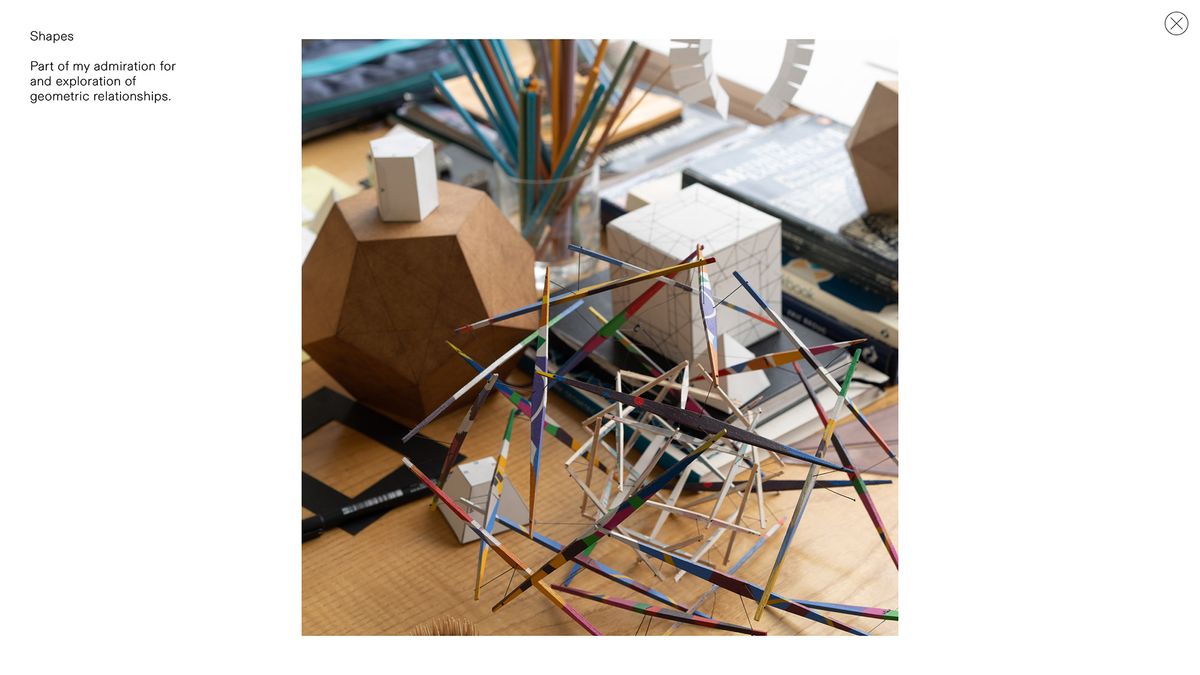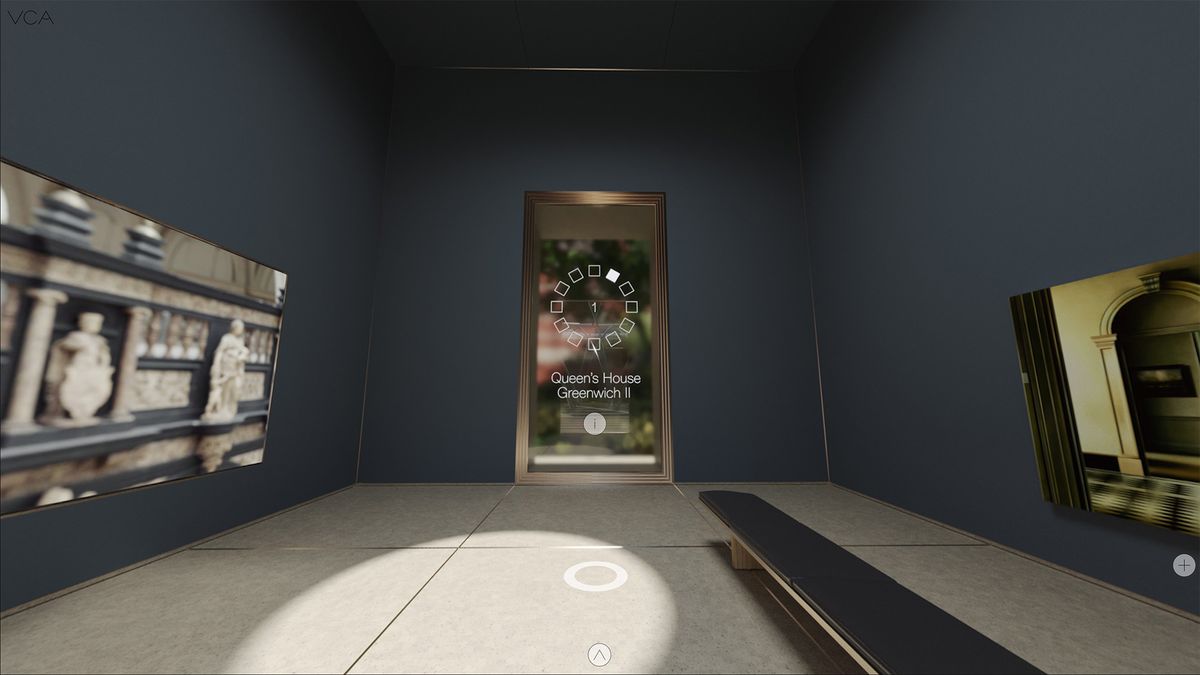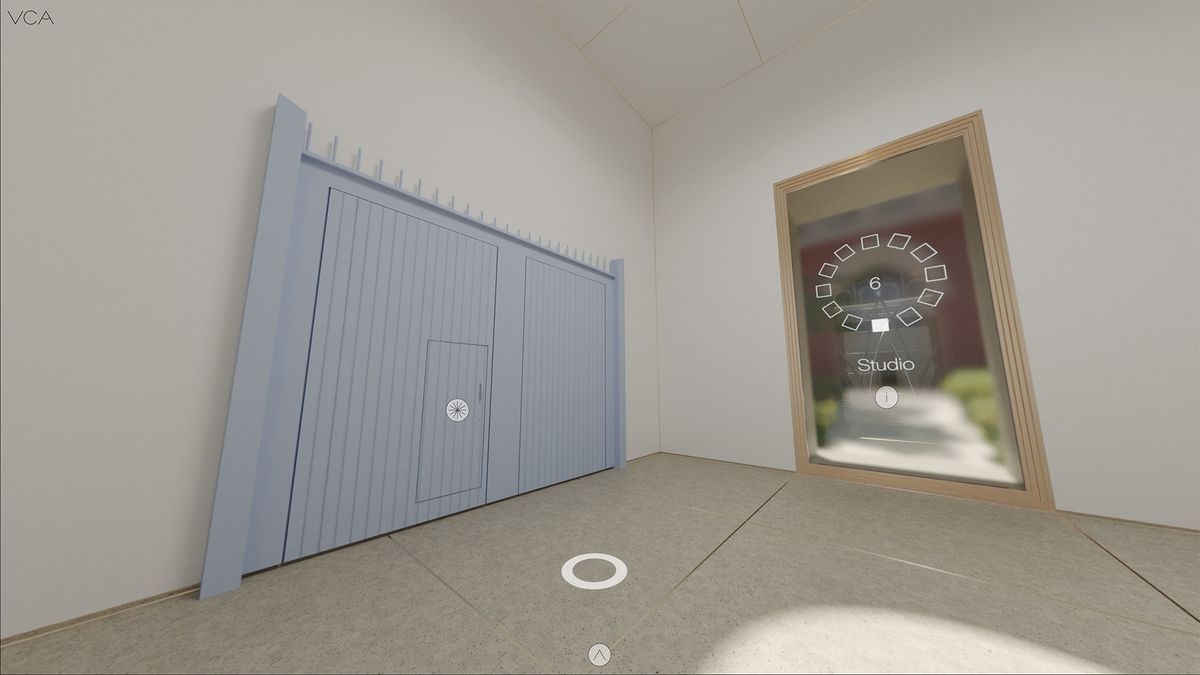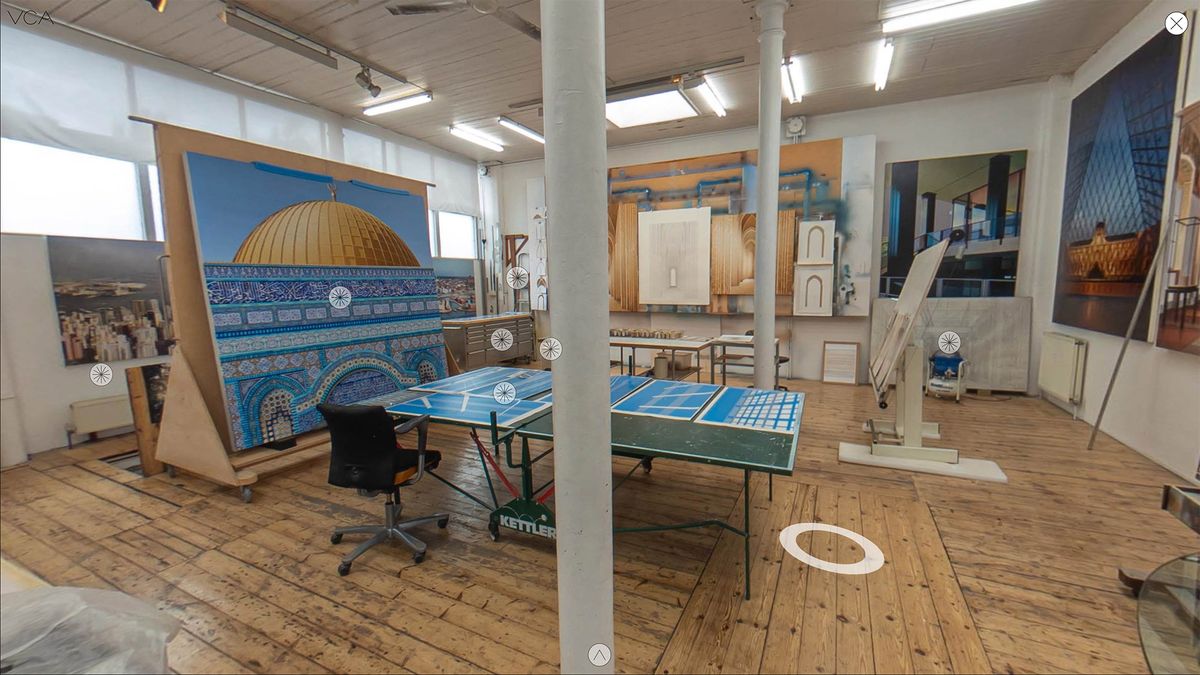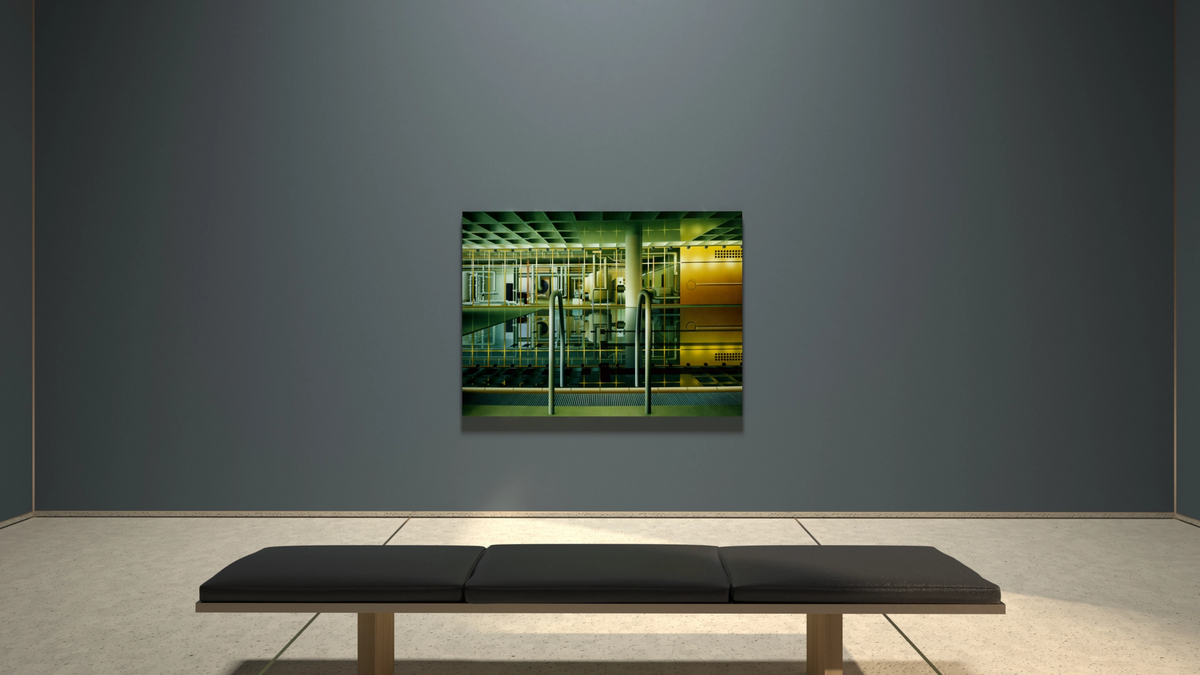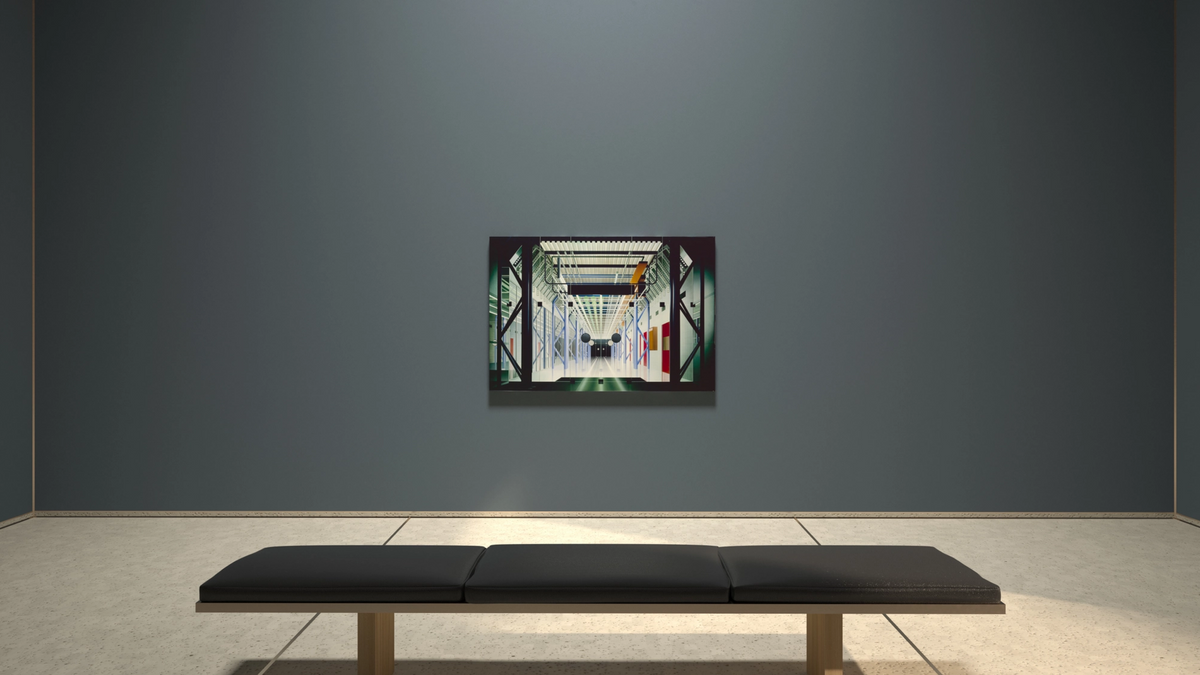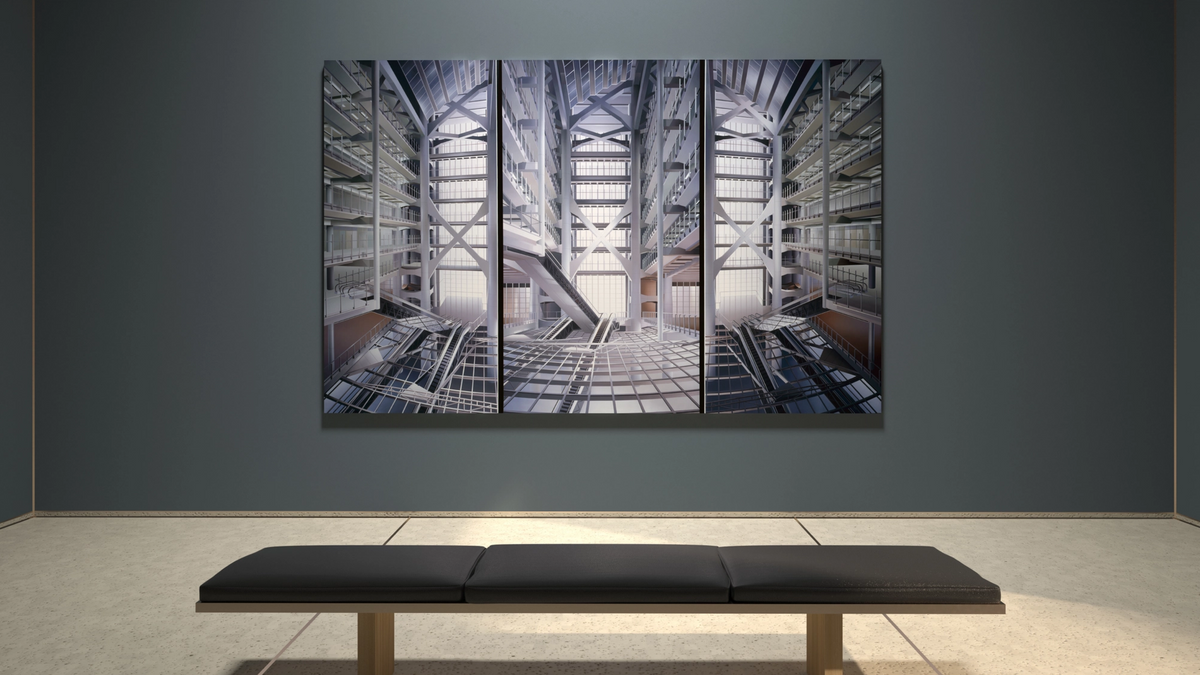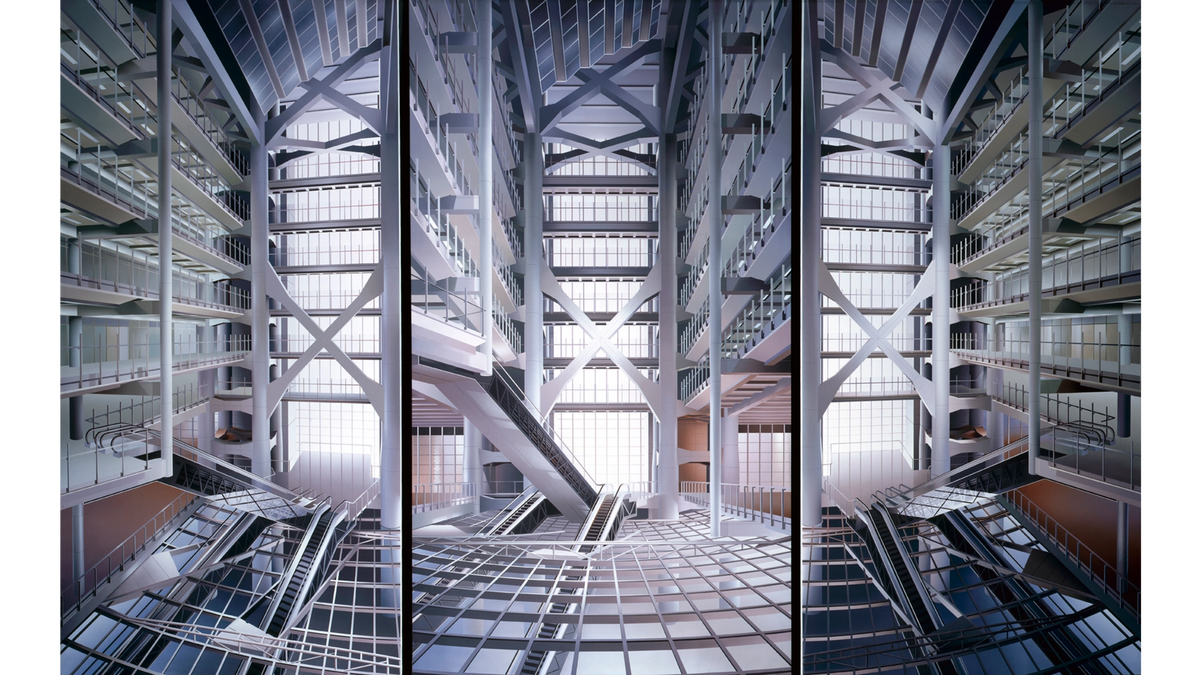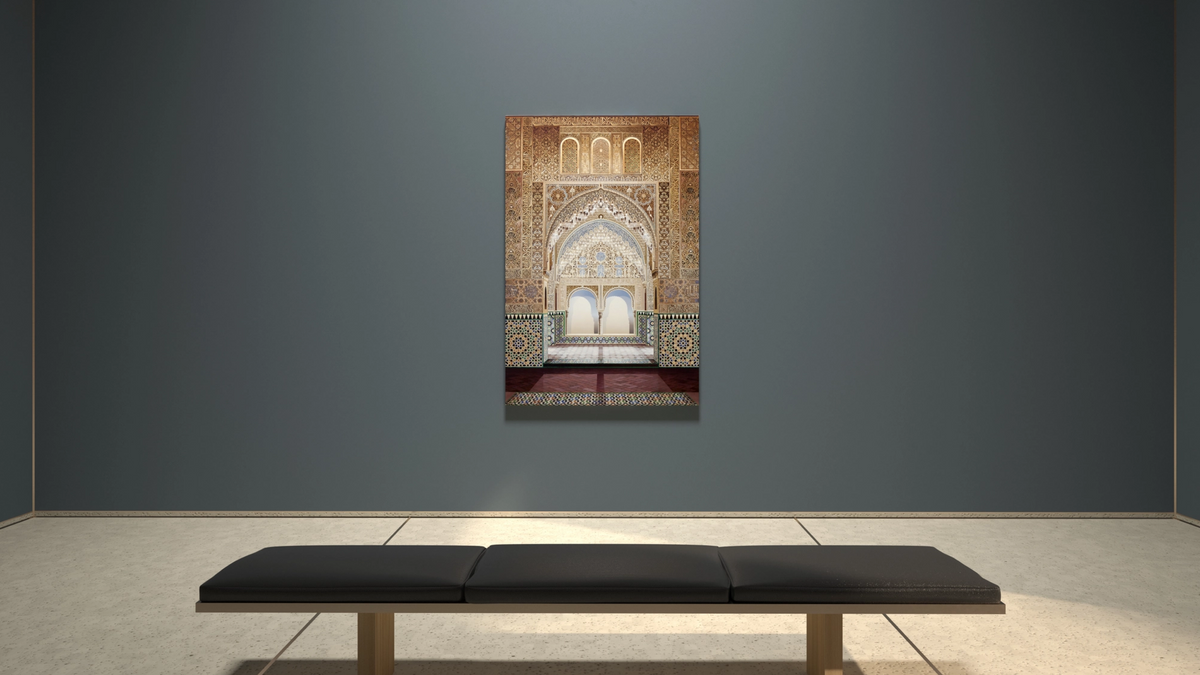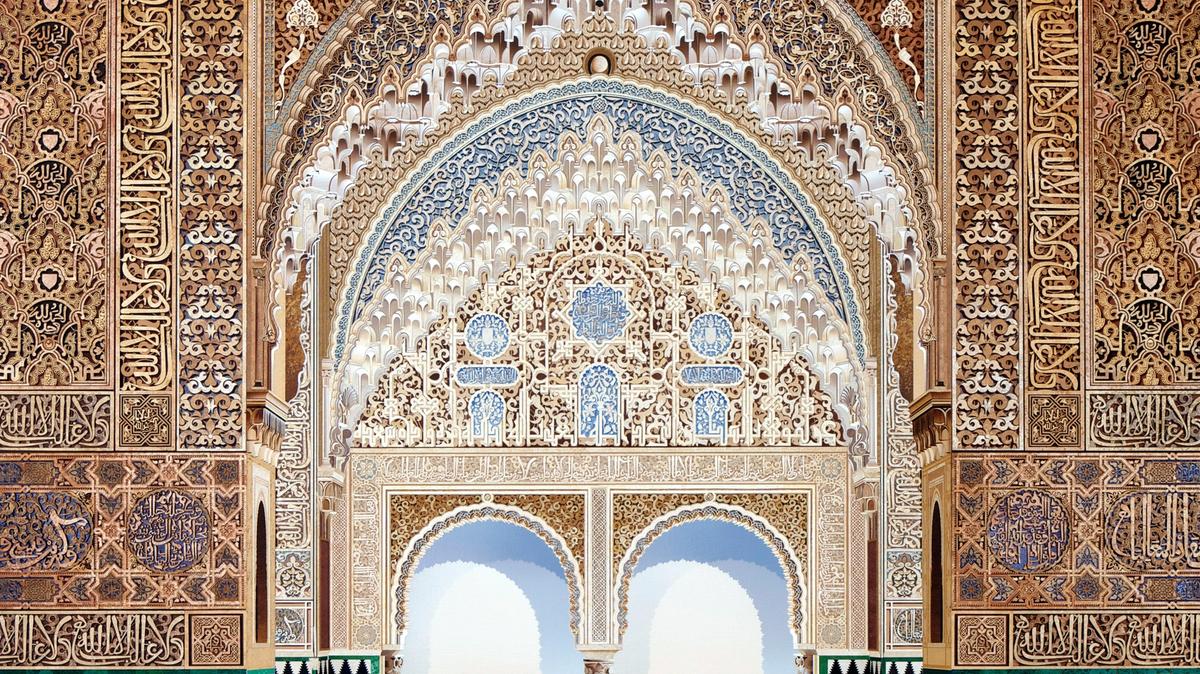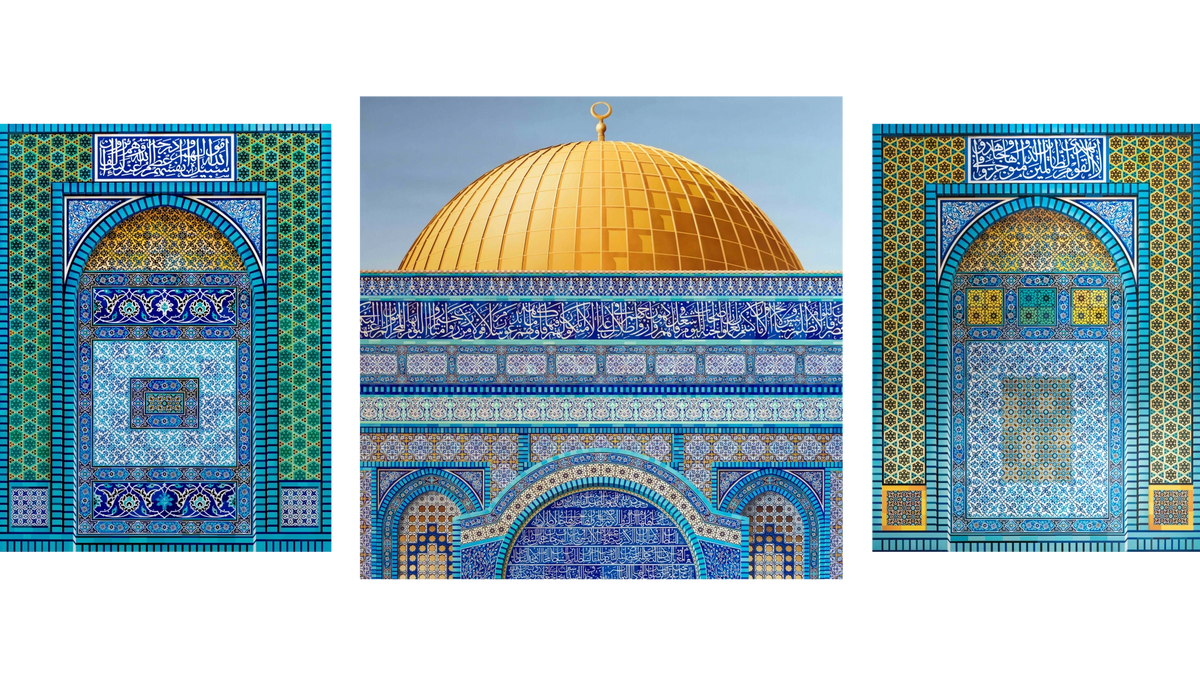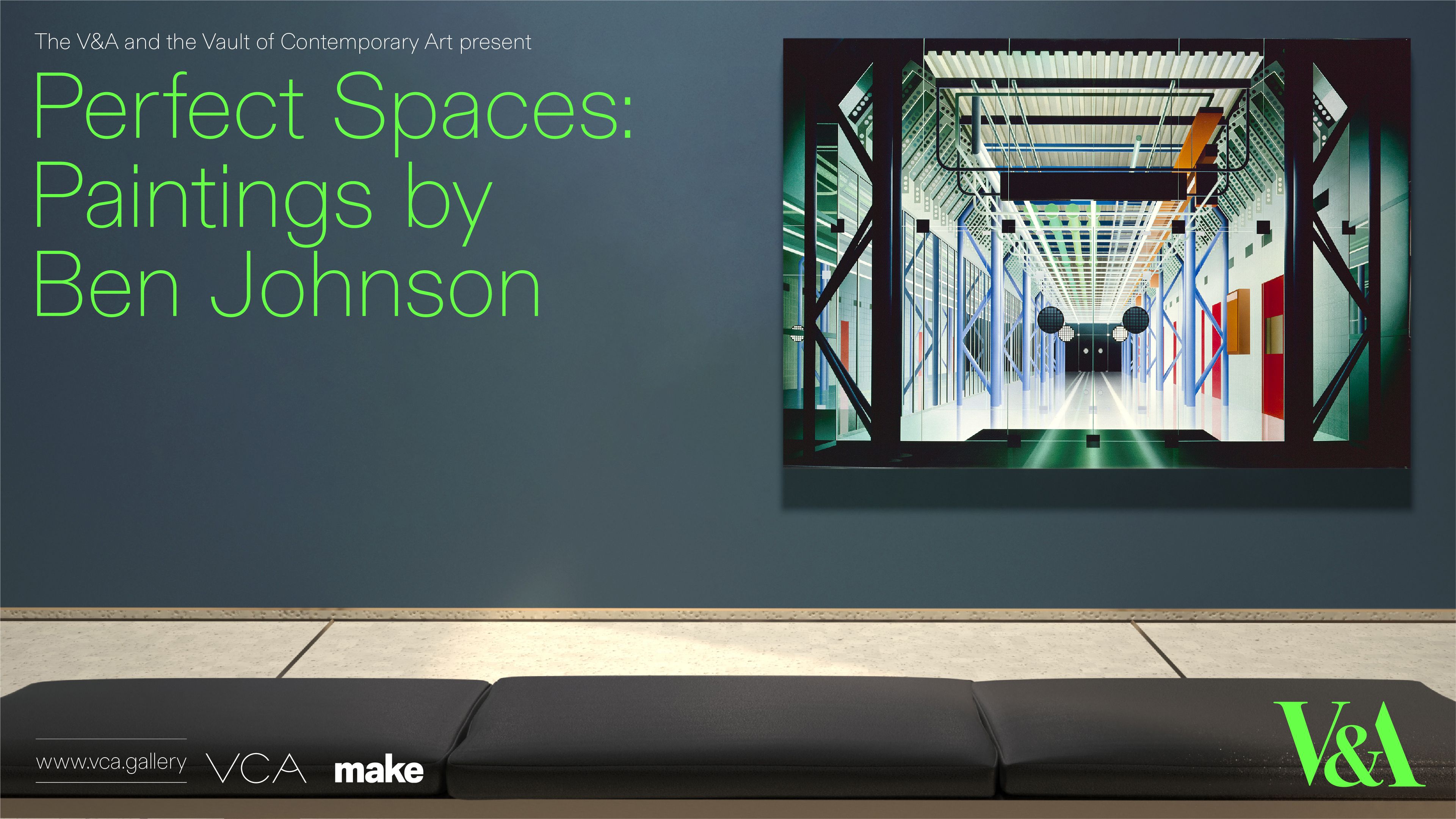
Perfect Spaces: Paintings by Ben Johnson.
- 16 June 2021 – 30 October 2021
- In partnership with the V&A and London Festival of Architecture
Ben Johnson says that his paintings “celebrate everything that I think is great in architecture and engineering. Not the ego of the architect, but the ambitions of architecture.“ Often confused with photorealism, his paintings explore complex perspectives, often constructed from impossible viewpoints, and sometimes depict lost buildings.
With their crystalline light, carefully chosen framing, and solemn solidity, they depict the powerful underlying geometry of the structures Johnson most admires. Devoid of people but nevertheless commemorating social places, his paintings seem timeless – perfect spaces in the Renaissance tradition of the ‘ideal city’. Together, they tell a history of architecture from Johnson’s unique viewpoint.
Johnson studied at the Royal College of Art in the 1960s, when it was based at the V&A, and his work is inspired by the museum’s collections. The paintings in his Perfect Spaces retrospective depict the Dome of the Rock, the Alhambra, the Crystal Palace, the HSBC Building, and the Neues Museum, each in its own room, whilst two others explore Johnson's artistic process. These works are the result of intense architectural study, built up slowly over many months of observation and drawing, often combined with digital technology. Visitors can learn about the buildings they depict, and the artist's techniques, in short films and a behind-the-scenes tour of his studio.
Curated by Christopher Turner, Keeper of Design, Architecture and Digital at the V&A, the exhibition marks the opening of the Vault of Contemporary Art (VCA). The gallery sits virtually in the V&A’s John Madejski Garden and was designed by Make Architects.
About the Artist
Ben Johnson was born in Llandudno, Wales, in 1946. He studied at the Royal College of Art (RCA) and has lived and worked in London since 1965.
His first solo exhibition was at the Wickersham Gallery in New York, in 1969, immediately after graduating from the RCA. He is best known for his paintings based on architectural spaces – some almost forensically accurate, others heavily manipulated – and his large-scale, intricately detailed cityscape paintings, which include panoramas of Hong Kong, Zürich, Jerusalem, Liverpool and, most recently, his view of London which was completed as part of a residency at the National Gallery, London, in 2010.
Over the past 46 years he has exhibited widely in galleries and museums across the world, including the Institute of Contemporary Arts, London; the Walker Art Gallery, Liverpool; the Art Institute of Chicago; Kunsthalle Tübingen; and the Museo Thyssen-Bornemisza, Madrid. At the first Venice Architecture Biennale in 1991, Norman Foster portrayed his work solely through Johnson's images, and he included him again in his 2012 Biennale installation. Johnson’s work was part of a travelling exhibition which toured museums in Europe from 2012–2017, with several venues achieving record visitor numbers. The first retrospective exhibition of his paintings opened in September 2015 at the Southampton City Art Gallery.
Johnson has for years been an Honorary Fellow of the Royal Institute of British Architects (RIBA), for his contribution to the public’s understanding of contemporary architecture, and in 2015 was made an Honorary Fellow of Glyndwr University, Wales, for services to the public appreciation of the arts. In 2017 he was made a Member of the Royal Cambrian Academy in Wales. He has undertaken commissions for the RIBA, the British Museum and National Museums Liverpool, as well as for IBM, HSBC, JP Morgan, British Steel, Hong Kong Telecommunications and many others.
His work is included in the permanent collections of museums worldwide, including the Victoria & Albert Museum, London; the Centre Pompidou, Paris; the Museum of Modern Art, New York; the Regional Services Museum, Hong Kong; and the UK’s Government Art Collection.
Artworks © Ben Johnson All rights reserved DACS.
Panel discussion
‘Perfect Spaces: Paintings by Ben Johnson’ launched at the Vault of Contemporary Art with a panel discussion chaired by Tamsie Thomson, Director of the London Festival of Architecture. The panel explored the future possibilities of virtual exhibitions, the challenges of educating and entertaining museum audiences digitally, and the lessons of lockdown.
Speakers
Ben Johnson, Artist
Christopher Turner, Keeper of Design, Architecture and Digital at the V&A
Kati Price, Head of Digital Media and Publishing at the V&A
Ken Shuttleworth, Founder, Make Architects
Greg Willis, Lead Architect of the VCA, Make Architects
Chaired by Tamsie Thomson, Director of the London Festival of Architecture
Gallery archive
A selection of screenshots taken inside the virtual gallery space.
Poolside Reflection, 1984
Acrylic on canvas
Collection of the Royal Institute of British Architects
159 x 217cm
This is based on the Willis Building in Ipswich, by Foster + Partners. Norman Foster has been a constant source of inspiration, from the very first building of his I saw on the Isle of Dogs in 1970 to his many subsequent buildings up to the present moment. I was never interested in the label of ‘high-tech’, or the unyielding steel and glass aesthetic which produces such seductive images; my interest was the social aspects of the architecture and the way the practice could bring joy and pleasure into people’s lives through the use of appropriate technology and the democratisation of spaces. Within the Willis Building there was no hierarchy of offices and rooms. People were treated as being part of one team. On the roof was a large, almost park-like area for people to have lunch and enjoy an open space, and on the ground floor, a swimming pool for all members of staff to use. The boiler room, which normally would have been hidden away in a basement, was brought up to share communal space. People in bathing suits could wave to the maintenance crew of the boiler room, where purely functional objects are laid out with such care and detail that they take on the quality of a sculpture park.
Inmos Central Spine, 1985
Acrylic on canvas
Private Collection
120 x 175cm
In 1982 I travelled to Newport to see the wonderful new building by the Richard Rogers Partnership. He had been commissioned to create a space which offered an opportunity for interaction between two sides of one company. The company produced microchips, and the producers of the microchip worked in the ‘clean’ area. Prior to this building, they would never meet the people from the so-called ‘dirty’ area, where all clerical and non-manufacturing activities took place. Rogers proposed a central spine which could become the ‘street’ on which the two aspects of the company would interact. It was to be a place for relaxation and socialising. A few years later, I returned to revisit this wonderful place and found that the vision had completely broken down. Pressure and demand for additional space had meant that storage had become more important than people’s friendships. The central spine no longer had enough space in which to sit and enjoy a cup of coffee. I decided that I would make a reconstruction of the vision which I had initially experienced. I wanted to re-present the first intentions with the greatest clarity I could.
Inmos Central Spine, 1985
Three Moments of Illumination, 1998
Acrylic on canvas
Collection of HSBC Holdings plc
274 x 432cm
This is based on the interior of the HSBC Headquarters in Hong Kong, one of Foster's most important and earliest triumphs, in 1986. I had long wanted to make this painting but refused to make it at anything other than a heroic scale – a scale which meant my proposals were refused by most collectors. It took until 1998 to find a brave client to house such a work. One of the enduring ambitions of Foster + Partners' designs is to bring a sense of pleasure to a working environment. Here there is an intense demand for a working space, and this could easily have led to an oppressive and dark interior. Instead, specially designed mirrored panels were utilised to capture light and share it over many floors and into deep spaces. The arrival to the main floor is a journey up an elegant escalator from the noisy and busy streets of a very modern city into a quiet and almost magical environment. I spent almost a week watching the light shift around the building and chose to make a triptych to celebrate these three moments of illumination. However exclusive the world of high finance has become; the underbelly of the building provides a meeting place for many thousands of Hong Kong's diverse communities.
Approaching the Mirador, 2013
Acrylic on canvas
Private Collection
225 x 150cm
Following the epic undertaking that the Liverpool cityscape proved to be, I was looking for a change no less important but perhaps slightly less complex in its realisation. The world of Islamic pattern, sacred geometry and the sheer beauty that is the Alhambra in Granada became the next area for my concentration. It was approximately 30 years previously that I had made my first visit to the Alhambra. It had a profound impact on my thinking as an artist. I was presented with geometry and mathematics as a means of conveying a deep, spiritual meaning to life, manifested through the skills of craftspeople and a culture that I was unfamiliar with. It then took another 15 years before I revisited and spent many weeks studying the buildings. This is the second of five completed large canvases, and I have made hundreds of studies relating to this extraordinary monument.
Approaching the Mirador, 2013
Dome of the Rock Triptych, 2017
Acrylic on canvas
Collection of the Artist
220 x 548cm
Around the turn of the millennium, as well as my preoccupation with cityscapes, I was working on a series of paintings for a peace foundation with the Khalili Family Trust. Their aim was to bring a greater understanding between the three Abrahamic faiths, using imagery from the city of Jerusalem. During my research I spent many hours on the Temple Mount and experienced the awe-inspiring beauty of the Dome of the Rock which, at one time, was the centre of the world. It is a building with a very rich and often mysterious background. It has a place both in history and mythology and was in the service, at different times, of many people with differing views. The temple was built over the Foundation Stone, which is believed the be the place where God created the world and Adam, where Abraham attempted to sacrifice his son, the place where God's divine presence is manifested more than in any other, and towards which Jews turn during prayer. The site's great significance for Muslims derives from traditions connecting it to the creation of the world and the belief that Muhammad's Night Journey to heaven started from the rock at its centre. I made the central panel and felt that was my final work, but I realised that reference had to be made to the eight walls that form the building’s octagonal base, and as the three paintings developed within the studio, they very logically came together as one. Each face carries several messages. Many of them communicate with our instincts and rely on pattern-making and colour to tell their story. However, also on each face is a quote from the Qu'ran and these quotes not only encourage devotion, but a journey around the building where messages of hope and truth are uncovered.


